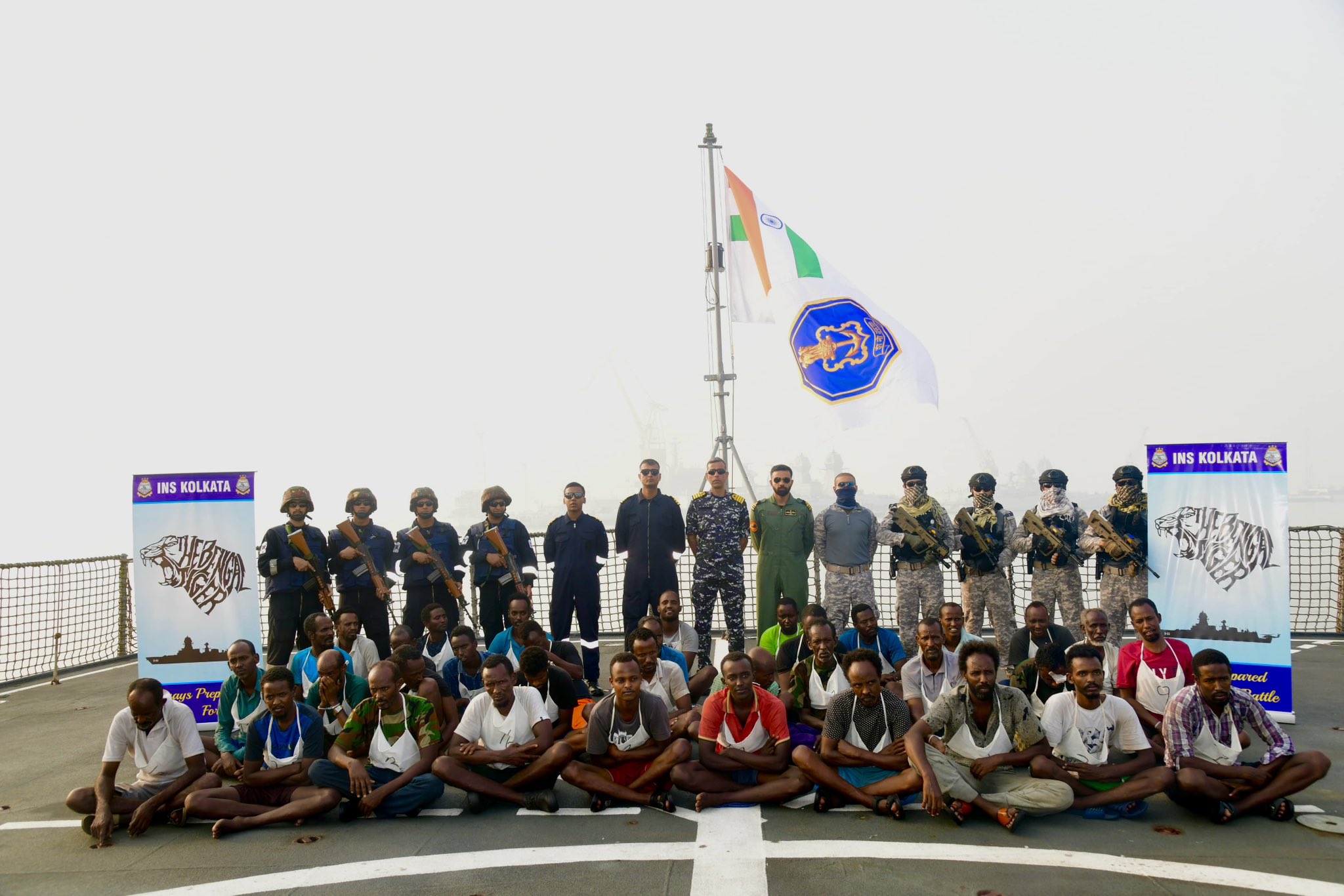By: Dr Pooja Bhatt
The high-octane anti-piracy operation against the hijacked MV Ruen gained admiration for the Indian Navy and underscored its position as the first responder in the Indian Ocean Region.
Apart from its marine commandos taking control of the merchant vessel following the maiden airborne raid, the incident has resulted in another first. The arrested 35 Somalian pirates will be prosecuted under India’s Maritime Anti-Piracy Act 2022, the first case under the law.
The Indian Navy forayed into the Gulf of Aden in 2008. Since then, while it grew confident in carrying out operations on the high seas to safeguard commercial vessels from the Somalian pirates, it lacked the legal backing to try them. More often than not, the pirates were disarmed and left adrift in the high seas.
The rescue of MV Ruen after 40 hours of high-tempo action that unfolded 1400 kilometers off India’s coast resulted in the arrest of 35 pirates. The Indian Navy’s warship INS Kolkata disabled the navigation system of the hijacked vessel, restricting its maneuverability.
#IndianNavy's Mission Deployed platforms respond to #hijacking in the #ArabianSea#MayDay msg from Malta Flagged Vessel MV Ruen on @UK_MTO portal – boarding by unknown personnel
Indian Naval Maritime Patrol Aircraft & warship on #AntiPiracy patrol immediately diverted@EUNAVFOR pic.twitter.com/mtXqjytSfF
— SpokespersonNavy (@indiannavy) December 16, 2023
The Indian Navy brought these 35 Somalian pirates for further legal recourse under the Maritime Anti-Piracy Act 2022. The Western Naval Command did an unprecedented job in coordinating the entire anti-piracy operation of this scale swiftly and without any harm and casualties that included joint planning, air ops, Visit Board Search and Seizure (VBSS) operations, negotiations with pirates, something even unheard of from the US Navy.
It also demonstrates India’s Maritime Domain Awareness and its capabilities to act, which have grown exponentially in the last few years. The operation also became a diplomatic high point when the Bulgarian PM thanked India for rescuing its nationals.
There has been an increase in serious incidents of maritime security in recent times. The terrorist attack on commercial and warships, drone attacks, piracy, and armed robbery in the Indian Ocean has a compounding effect on global shipping prices, insurance, and the safety of seafarers.
It is to be noted that the Indian Ocean High-Risk Area for Piracy was removed in January 2023 after more than a decade of anti-piracy efforts by several navies, including India. The West Asian crisis now impacts the maritime domain as well.
Importance Of MV Ruen Case
The MV Ruen case is historical and crucial. It is the first arrest of pirates under the newly adopted domestic maritime law, the Maritime Anti-Piracy Act 2022 (MAP 2022), which gives effect to International maritime laws, namely the United Nations Convention on the Laws of the Seas.
MAP 2022 renders acts of maritime piracy and armed robbery within the Indian Exclusive Economic Zone and beyond punishable under Indian law and lead to imprisonment for life and even death sentences for the perpetrators.

The pirates were brought to India on March 23 and were handed over to the Mumbai police. They will face charges of ransom demands. The court on March 25 sent the 35 pirates for 10 days remand while the charges are being framed for kidnapping for ransom, extortion, criminal conspiracy, wrongful confinement, attempted murder, and criminal intimidation.
The hiccup that the prosecution is facing is that the accused pirates only speak the Somali language, forcing the Mumbai police to obtain a translator.
The offenses are considered extraditable in the countries with which India has signed extradition treaties. Until now, the perpetrators of similar arrests were made by the Indian Navy and Coastguards and put in a few dedicated prisons, such as Mumbai’s Yellow Gate Police Station and others. However, due to a lack of jurisdictional and operational clarity between maritime-related agencies and courts, most fishermen and pirates were acquitted after a few years.
Maritime Anti-Piracy Act
For a successful case adjudication, the first step is to provide strong evidence proving that the perpetrators were indeed pirates.
This could be easily sorted out here due to the immaculate Navy’s video proof being circulated on social media. The MAP 2022 also provides India with jurisdiction for preventing piracy in the High Seas, which clears the jurisdictional hurdle, too.
Hence, India is in a stronger position this time because of the documentary proof and jurisdictional clarity that it fell short in not similar but previous maritime incidents such as the 2008 Mumbai attack, the 2012 Enrica Lexie case, the 2013 Seaman Ohio Arms transfer case, etc.
While maritime law enforcement agencies have proven their side, the next step is up to the over-stretched and under-resourced Indian courts for further action.
Ascertaining the nationality and language of the convicted pirates, determining their age if juvenile and other on-the-ground hurdles elongate the trial process at the courts. Also, the well-being of foreign nationals while in jail has become an issue for Indian authorities.
At the diplomatic level, India does not have an extradition treaty or arrangement with Somalia, but they signed the Transfer of Prisoners agreement in 2017.
It is not the first time that Indian courts have prosecuted Somali pirates. In 2011, the Indian Coast Guard arrested 27 pirates who were successfully tried in an Indian court for a merchant ship attack case, but they were deported after serving six years in prison in 2017 to serve the remaining term of the sentence in their respective countries.
With MAP 2022 in place, the future role of the MV Ruen pirate case is to be seen.
While the MAP law 2022 does reduce the grey zone governance of the Indian EEZ and the High Seas, more needs to be done to strengthen the entire architecture, which includes domestic maritime law enforcement agencies such as the Navy, Coastguard, marine police, adjudicating courts at all levels, and India’s diplomatic relations with other countries.
Maritime Governance For Emerging Maritime Threats
Nonetheless, it once again established India’s strengthened position in the IOR and its commitment to secure seas.
With India as an emerging power, serious thinking about maritime security, governance, and policymaking must occur to address the existing and newly emerging threats in the maritime domain, such as critical subsea infrastructure, autonomous underwater vehicles, foreign research vessels, etc., in a comprehensive manner.
Dr Pooja Bhatt is an independent maritime author and analyst based in New Delhi.




